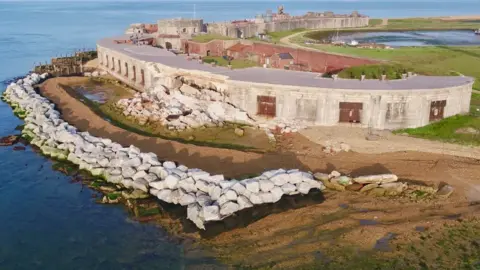Hurst Castle: New warnings over potential wall collapses
 English Heritage
English HeritageRepairing damage to a castle originally built by Henry VIII, which partially collapsed in February, will be "no quick fix", English Heritage has said.
A section of Hurst Castle's 19th Century east wing, near Milford-on-Sea, Lymington, came down following storms.
Work has begun to inject specialist resin to consolidate the shingle which underlies its foundations.
However, English Heritage said it had detected "renewed movement" and cannot rule out further collapses.
Using 5,000 tonnes of Cornish granite boulders, work began in May to construct a 90m (295ft) revetment or retaining wall, which extends into the Solent to protect the east wing from the sea.
English Heritage's estates director Rob Woodside said: "We have always been clear that there can be no quick fix to the issues it is facing and our monitoring over the spring and summer has revealed an even more complicated picture, including renewed movement within the walls not only in the east wing, but also in the west wing."
 RenoufDesign
RenoufDesign"The immense forces at work along Hurst Spit continue to present a very real challenge," he added.
"Despite our efforts in recent years, the advice we have received from our experts is that they are unable to rule out further collapse in the Victorian east and west wings."
He said there was no threat to the castle's Tudor keep.
The castle has reopened to the public although the east and west batteries remain closed.
Hurst Castle was originally built by Tudor king Henry VIII between 1541 and 1544 to guard Needles Passage, which is the narrow western entrance between the Isle of Wight and the mainland.
From 1860, the large east and west wing batteries were added as part of a defence programme.
The castle was also used for searchlights and guns during World War One and World War Two.
 James Brooke
James Brooke 
Follow BBC South on Facebook, Twitter, or Instagram. Send your story ideas to [email protected].
